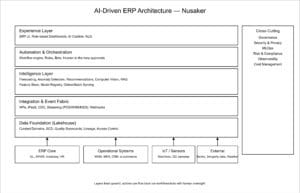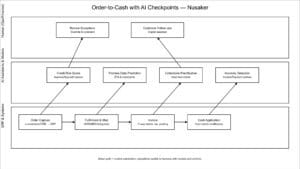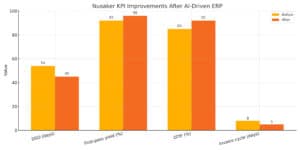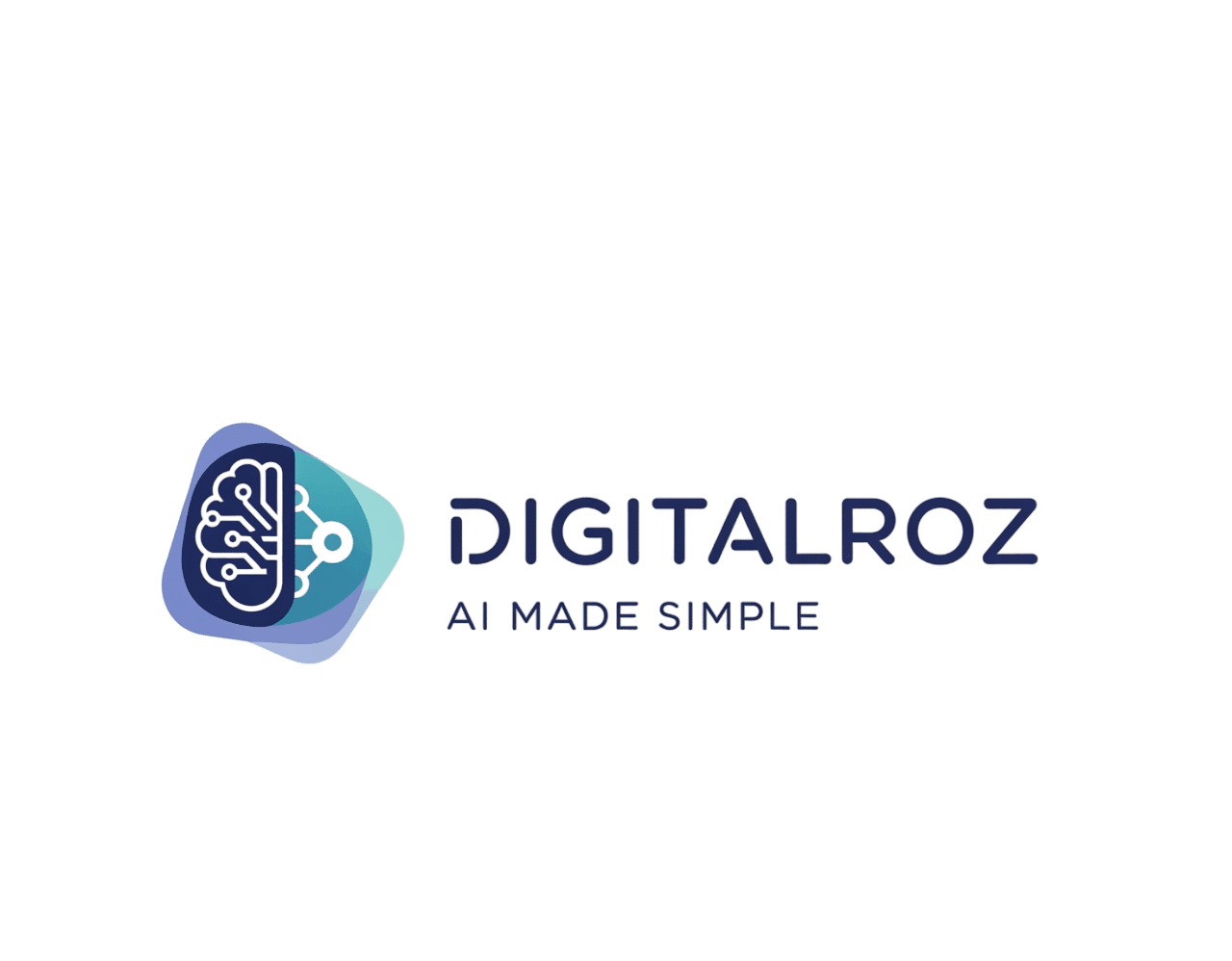AI driven ERP systems future of Nusaker isn’t hype. It’s a practical operating model where machine learning, automation, and intelligent assistants hard‑wire continuous improvement into finance, supply chain, HR, and customer operations. In this guide you’ll see what an AI‑ready ERP looks like, how to roll it out in 12 months, what to measure, and how to de‑risk adoption so people actually use it.
Every few years a technology comes along that doesn’t just add a feature to Enterprise Resource Planning, it redefines what an ERP is for. That’s where we are with AI. For Nusaker, an ambitious, forward‑leaning organization (use this term for your company, region, or platform), the phrase ai driven erp systems future of nusaker signals a shift from systems of record to systems of reasoning. Your ERP stops being a ledger that records what just happened and becomes an intelligence layer that predicts what will happen next and quietly automates the right action.
Table of Contents
- What We Mean by “Nusaker”
- Why AI‑Driven ERP Matters Now
- How AI Rewires Each ERP Module
- Reference Architecture
- 12‑Month Roadmap
- Ten High‑Impact Use Cases
- Build vs. Buy vs. Hybrid
- Governance, Security & Ethics
- KPIs to Prove Value
- Cost & ROI
- Change Management
- Anti‑Patterns
- Implementation Checklist
- FAQ
- Glossary
- Putting It All Together
What We Mean by “Nusaker”
For the purpose of this article, Nusaker is a stand‑in for your business or ecosystem that wants to operate with modern, data‑driven discipline. Whether you’re a manufacturer, a services network, a multi‑brand retailer, or a civic region modernizing shared services, the principles here apply. Replace “Nusaker” with your own entity and you’ll have a blueprint tailored to your context.
Two assumptions shape the recommendations below:
- You already have an ERP (or are about to choose one) and a mix of spreadsheets and point solutions around it.
- You want AI to simplify work, not complicate it, augmenting people with automation, not replacing them.
Layers of Nusaker’s AI‑driven ERP—how data, models, and automation combine to deliver decisions and actions

This architecture is a conceptual framework. Each ERP vendor (SAP, Oracle, Microsoft, etc.) may design different variations.
Why AI‑Driven ERP Matters Now
Traditional ERP excels at structure and control. In ai driven erp systems future of nusaker, the world Nusaker competes in is probabilistic: demand rises and falls, suppliers slip, employees churn, and customers expect instant answers. AI fills the gap between rigid processes and messy reality by learning patterns from your data and acting on them. Practically, that means:
- Predictive planning: From cash‑flow and revenue forecasting to demand and labor planning.
- Anomaly detection: Spotting fraud‑like events, late‑risk POs, outlier invoices, and quality deviations.
- Autonomous workflows: Bots that approve routine items, reconcile accounts, or reschedule shipments.
- Natural‑language assistance: Ask “What’s driving margin compression in Q3?” and get a breakdown with next steps.
- Decision intelligence: Simulate scenarios (price changes, supplier swaps, staffing shifts) before committing.
The result is not just efficiency; it’s optionality, the ability to respond faster with less friction.
How AI Rewires Each ERP Module (at a Glance)
The most effective way to envision the ai driven erp systems future of Nusaker is to map AI capabilities to the modules business leaders already understand.
| ERP Module | What AI Adds | Example Outcome |
|---|---|---|
| Finance | Predictive cash, risk‑scored payables/receivables, autonomous close | Days Sales Outstanding drops; close cycle shortens |
| Supply Chain & Procurement | Demand sensing, supplier risk scoring, dynamic safety stock | Higher fill‑rates with lower inventory |
| Manufacturing/Operations | Predictive maintenance, quality vision models, digital twins | Fewer unplanned stops; higher first‑pass yield |
| Sales & CRM | Lead propensity, next‑best‑offer, churn signals | Higher conversion and retention |
| HR & Workforce | Attrition risk, skill mapping, AI‑assisted scheduling | Lower turnover, smoother staffing |
| Projects/Services | Effort estimates, margin prediction, resource matching | More accurate bids; better utilization |
| Customer Service | AI copilots, intent routing, knowledge suggestions | Faster resolution, higher CSAT |
The Reference Architecture for Nusaker’s
Think of the target state as five interoperable layers:
- Data foundation: A governed lakehouse that ingests ERP tables (GL, AP/AR, inventory), logs, IoT, and external feeds. Unified IDs and slowly changing dimensions keep history intact.
- Event & integration fabric: Streaming from POS/WMS/MES; CDC from ERP; APIs to payroll, banking, e‑commerce.
- Intelligence layer: Models for forecasting, anomaly detection, recommendations, and computer vision, plus retrieval‑augmented generation (RAG) over curated knowledge.
- Automation layer: Orchestrated workflows and bots that can take action with guardrails (e.g., auto‑approve low‑risk invoices under limits, trigger purchase orders when thresholds hit).
- Experience layer: Role‑aware dashboards and AI copilots embedded in ERP screens and chat, with natural‑language queries and explainability.
Cross‑cutting concerns: MLOps, data governance, security/privacy, observability and cost management.
A 12‑Month Roadmap (Pragmatic and Bite‑Sized)
You don’t need a moonshot. You need momentum. Here’s a realistic plan for Nusaker:
Months 0–1: Alignment & Baseline
- Pick one value stream (e.g., Order‑to‑Cash). Define 3 business KPIs (e.g., DSO, % on‑time delivery, gross margin).
- Inventory data sources; map data contracts for the chosen process.
- Establish a cross‑functional squad: process owner, data engineer, ML lead, ERP functional lead, change manager.
Months 2–3: Data Plumbing & Quick Wins
- Set up ELT into your lakehouse; validate data quality and dimensional conformance.
- Launch one no‑regrets automation (e.g., auto‑match low‑value invoices with 3‑way match rules).
- Create a baseline dashboard for the three KPIs; publish weekly.
Months 4–6: First Intelligence Loop
- Train a demand or cash‑flow forecast; compare to manual forecasts.
- Deploy an anomaly detector for AP/AR and procurement price variance; route alerts to owners.
- Pilot an ERP copilot for natural‑language questions about the chosen value stream.
Months 7–9: Scale to Adjacent Modules
- Extend models to supply planning, inventory optimization, or workforce scheduling.
- Expand automation to include human‑in‑the‑loop approvals; set clear thresholds.
- Start a digital twin of the value stream to simulate policy changes (payment terms, reorder points, shift patterns).
Months 10–12: Institutionalize & Expand
- Formalize AI change management: role‑based training, champions, community of practice.
- Codify model risk management (versioning, monitoring, bias checks, fallback plans).
- Roll the playbook to the next value stream (Procure‑to‑Pay, Plan‑to‑Produce, or Hire‑to‑Retire).
Ten High‑Impact Use Cases for Nusaker (with “Why It Sticks”)
- Predictive cash and collections. Forecast receipts by customer and recommend the next action. Why it sticks: Finance sees fewer surprises and clearer working‑capital levers.
- Invoice automation with anomaly checks. Straight‑through processing for small, low‑risk invoices; route exceptions with explanations. Why it sticks: AP teams get time back without losing control.
- Demand sensing across channels. Use recent sales signals and seasonality to update the plan daily. Why it sticks: Planners get guardrails, not black boxes.
- Smart replenishment and dynamic safety stock. Tie safety stock to real variability, not rules of thumb. Why it sticks: Service levels up, carrying costs down.
- Predictive maintenance. Combine sensor data with work‑order histories to schedule maintenance right before failure. Why it sticks: Fewer line stops and cheaper parts.
- Computer‑vision quality gates. Cameras + models catch defects earlier. Why it sticks: Scrap falls; inspectors focus on edge cases.
- Attrition risk & skill mapping. Identify teams at risk and recommend growth moves. Why it sticks: Managers get early warnings and actionable options.
- Copilot‑assisted customer service. Summarize cases, suggest replies, and surface knowledge articles. Why it sticks: Faster responses, better consistency.
- Project margin prediction. Predict variance before it happens and recommend staffing or scope steps. Why it sticks: Project managers protect margin proactively.
- Sales propensity & pricing guidance. Score opportunities and nudge reps on price corridors. Why it sticks: More wins with disciplined discounting.

This diagram is a conceptual model showing how AI can augment ERP workflows. Real implementations may differ by vendor and organization
Build vs. Buy vs. Hybrid: What Fits Nusaker?
Buy (ERP vendor native AI). Pros: deep integration, faster basics (forecasting, anomaly alerting, copilots). Cons: less control over models/data; roadmap tied to vendor.
Build (your models on your stack). Pros: full control, competitive differentiation, custom features. Cons: higher talent needs; longer time‑to‑value.
Hybrid (most common). Buy the table‑stakes capabilities from your ERP vendor, then augment with custom models in priority areas (pricing, demand, churn). This keeps velocity high while reserving your scarce data‑science cycles for what truly sets Nusaker apart.
Governance, Security & Ethics (Non‑Negotiables)
- Data governance: Clear ownership for each domain, authoritative sources of truth, PII tagging, retention policies, and lineage.
- Access control: Principle of least privilege; separate duties; robust audit trails for automated actions.
- Model governance: Documented intent, approved features, change logs, drift monitoring, and human overrides.
- Safety & bias: Test for disparate impact; set thresholds; provide explanations where outcomes affect people.
- Privacy & compliance: Align with local regulations on data residency, consent, and automated decision‑making.
- Incident response: Playbooks for model failures, data leaks, and automation gone wrong; fast rollback switches.
KPIs to Prove Value (and Keep Everyone Engaged)
Pick a north‑star metric per value stream and track leading indicators:
Order‑to‑Cash
- DSO, on‑time full delivery (OTIF), % automated collections tasks, forecast accuracy.
Procure‑to‑Pay
- % straight‑through invoices, cycle time, price variance caught by AI, supplier on‑time.
Plan‑to‑Produce
- Schedule adherence, unplanned downtime hours, first‑pass yield, scrap rate.
Hire‑to‑Retire
- Time‑to‑fill, 90‑day attrition, skills coverage index, % schedules auto‑generated.
Customer Support
- First‑contact resolution, average handle time, deflection via self‑service, CSAT/NPS.
Report weekly wins (small deltas) and quarterly outcomes (sustained movement). The former keeps momentum, the latter secures budget.
Cost, ROI, and a Simple Business Case
You don’t need perfect precision; you need a defensible model everyone understands. Try this structure:
Benefits (annualized)
- Labor hours saved (automation x frequency x time per task).
- Working‑capital impact (DSO/Inventory days delta x cost of capital).
- Revenue lift (conversion/uplift x average order value x volume).
- Risk reduction (fraud/chargebacks avoided, penalty fees, compliance findings).
Costs (year 1)
- Software (ERP AI add‑ons, orchestration, data platform).
- Implementation (integration, data modeling, model development).
- Change & training (time, materials, champions program).
- Run (cloud, monitoring, model refresh, support).
ROI Method: (Net Benefit) / (Total Cost). Build three scenarios—conservative, expected, stretch—and attach decision gates to move forward.
Pro tip: Express benefits in unit terms (minutes per invoice, cost per order, margin per project). Unit economics keep the conversation honest.

This chart is for illustrative purposes. Actual KPI improvements may vary depending on industry, data quality, and ERP implementation.
Change Management So People Actually Use It
Technology adoption is a human story. Bake in these habits:
- Co‑design with frontline users. Put prototypes in their hands early; keep what they love, ditch what they ignore.
- Explainability by default. Provide plain‑English reasons for model outputs and easy ways to challenge them.
- Guardrails, not gates. Use thresholds and auto‑reverts; allow managers to override with a note.
- Skills enablement. Short role‑based modules (15–30 minutes), not dense manuals. Make champions visible.
- Change theater → change reality. Replace “launch day” with graduated rollouts: pilot → limited availability → general availability.
- Celebrate small wins. A 5% improvement now beats a 50% promise “later.” Momentum compounds.
Anti‑Patterns to Avoid (Learned the Hard Way)
- Boiling the ocean. Don’t attempt six value streams at once. Win one, then templatize.
- Model first, data later. Fix data contracts and quality before building fancy models.
- Shadow AI. RPA or spreadsheets making critical decisions out of sight—consolidate into governed platforms.
- Automation without audit. Every bot needs an owner, an SLA, and an evidence trail.
- Dashboards as deliverables. Insights without action don’t move KPIs; wire decisions to workflows.
- Vanity AI. If a use case doesn’t tie to a KPI or regulatory need, pause it.
Implementation Checklist (Keep This Near Your Keyboard)
- Scope one value stream and 3 KPIs
- Data map + quality scorecards
- Minimal lakehouse + CDC from ERP
- First automation with human‑in‑the‑loop
- Forecast + anomaly detector in production
- Copilot embedded into ERP screens
- Governance: access, lineage, and model risk
- Training: role‑based modules + champions
- Weekly wins log; quarterly outcomes review
- Roll pattern to next value stream
Frequently Asked Questions (Quick, Direct Answers)
Q1: What makes an ERP “AI‑driven” rather than just “ERP with reports”?
An AI‑driven ERP doesn’t just show you yesterday—it learns from history and context to predict, recommend, and act. It fuses machine learning, business rules, and automation so that many routine decisions happen autonomously with transparent guardrails.
Q2: Do we need a brand‑new ERP to reach this future for Nusaker?
Not necessarily. Most modern ERPs include AI features, and many allow you to augment with your own models. Start with a hybrid approach: vendor basics + custom differentiation.
Q3: Will AI replace jobs?
Expect roles to evolve, not vanish. Mundane tasks shrink; analytical, creative, and relationship work grows. Plan reskilling early and show the path for each role.
Q4: How do we prevent biased or unsafe decisions?
Treat models like policies: document intent, test for fairness, monitor drift, and keep humans in the loop where outcomes affect people or compliance.
Q5: What’s a sensible first use case?
Pick something measurable and low‑risk, invoice automation, collections prioritization, or demand sensing on a focused SKU set. Ensure data quality is high and feedback loops are tight.
Q6: How much data do we need?
Enough to capture the variability of the decision you’re trying to automate. For forecasting, that’s typically 18–24 months of history; for anomaly detection, wide and clean feature sets matter more than sheer volume.
Q7: What about small or mid‑size teams?
Start narrow. Cloud‑native tools, templated models, and managed services can deliver outsized value without big teams—if you anchor on KPIs and guardrails.
Glossary (So Everyone Speaks the Same Language)
- ERP (Enterprise Resource Planning): The system that runs core finance, supply chain, HR, and operations.
- Copilot: A natural‑language assistant embedded in business apps that can answer and act with permission.
- Lakehouse: A modern data architecture blending a data lake’s scale with a warehouse’s structure.
- RAG (Retrieval‑Augmented Generation): Using your verified knowledge base to ground AI answers.
- MLOps: The discipline of deploying, monitoring, and governing machine‑learning models in production.
- Digital twin: A simulation of a process or asset used for “what‑if” experiments.
- Human‑in‑the‑loop: A person verifies or overrides an automated step before it’s finalized.
Putting It All Together (A Future You Can Ship)
The ai driven erp systems future of nusaker is not a buzzword to chase; it’s a blueprint to execute. Start with one value stream, wire data to decisions, automate the obvious with oversight, and expand deliberately. Measure what matters, design for people, and keep your governance boring and reliable. Do that, and your ERP becomes a competitive advantage that compounds—an operating system for better decisions at scale.
Next step: Copy the checklist above into your tracker, pick Order‑to‑Cash or Procure‑to‑Pay, book a 45‑minute working session, and move the first automation into production this month. Momentum beats perfection.
